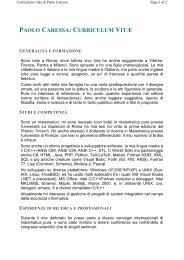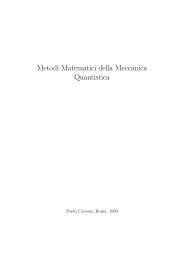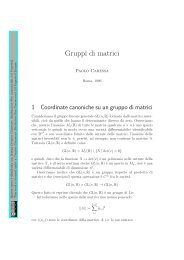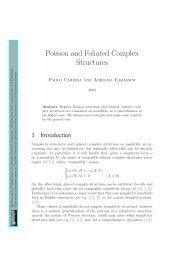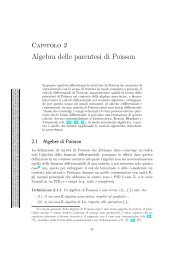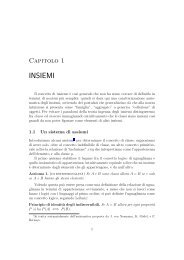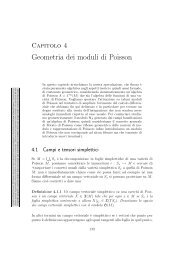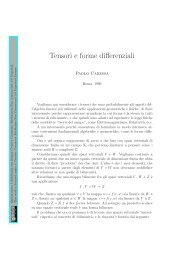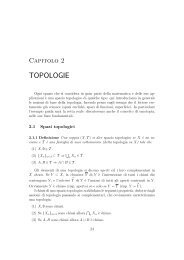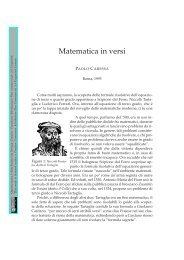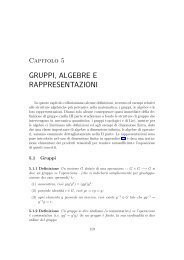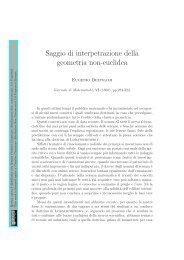You also want an ePaper? Increase the reach of your titles
YUMPU automatically turns print PDFs into web optimized ePapers that Google loves.
34 Paolo <strong>Caressa</strong>La <strong>di</strong>mostrazione è una pura verifica tecnica: può trovarsi in [13] e [15].Osserviamo che la con<strong>di</strong>zioneη xy = Ad y −1η x +η yesprime il fatto che η : G → g∧g è un 1-cociclo <strong>di</strong> G a valori nel G-modulog∧g.Un corollario imme<strong>di</strong>ato ed interessante <strong>di</strong> queste caratterizzazioni è chel’ident<strong>it</strong>à del gruppo {e} forma da sola una foglia simplettica, dato che iltensore <strong>di</strong> <strong>Poisson</strong> in essa è sempre nullo: π e = π ee = 2π e .Questo fatto è notevole, perchè ci <strong>di</strong>ce, ad esempio, che la struttura <strong>di</strong><strong>Poisson</strong> <strong>di</strong> un gruppo <strong>di</strong> Lie–<strong>Poisson</strong> non può mai essere simplettica. Nonesiste cioè una nozione ben defin<strong>it</strong>a <strong>di</strong> “gruppo simplettico” che sia un casoparticolare della nozione <strong>di</strong> gruppo <strong>di</strong> Lie–<strong>Poisson</strong>. Ha senso definire strutturesimplettiche su gruppi <strong>di</strong> Lie che siano invarianti rispetto alla strutturagruppale, ma si ottiene qualcosa che non è imparentato con le nozioni che quistiamo trattando.Abbiamo dunque che un 2-tensore controvariante su un gruppo <strong>di</strong> Lie G,lo rende un gruppo <strong>di</strong> Lie–<strong>Poisson</strong> se e solo se sod<strong>di</strong>sfa le due con<strong>di</strong>zioni <strong>di</strong>integrabil<strong>it</strong>à e <strong>di</strong> compatibil<strong>it</strong>à:[π,π] s = 0π xy = dL x π y +dR y π xLaprimacon<strong>di</strong>zione èunaformulazionedell’ident<strong>it</strong>à <strong>di</strong>Jacobiperleparentesi<strong>di</strong> <strong>Poisson</strong> indotte da π, mentre la seconda è una con<strong>di</strong>zione <strong>di</strong> 1-cociclo.Vogliamo ora vedere come queste con<strong>di</strong>zioni si possono riformulare in modoinfin<strong>it</strong>esimale, utilizzando cioè l’algebra <strong>di</strong> Lie g del gruppo.Sappiamo dalla prima con<strong>di</strong>zione che C ∞ (G) è un’algebra <strong>di</strong> Lie, il checi <strong>di</strong>ce che lo è anche C ∞ (e), l’algebra dei germi <strong>di</strong> funzioni intorno al puntoun<strong>it</strong>à e ∈ G:∀f,g ∈ C ∞ (e) {f,g} := {f,g}Se consideriamo l’idealem := {f ∈ C ∞ (e)|f(e) = 0}dei germi nulli in e, allora, dato che π e = 0:{C ∞ (e),C ∞ (e)} ⊆ me quin<strong>di</strong> m è un ideale <strong>di</strong> Lie, come pure lo è m 2 . Quin<strong>di</strong> T ∗ e G ∼ = m/m 2 èun’algebra <strong>di</strong> Lie e, dato che si identifica con g ∗ , abbiamo che anche g ∗ lo è.




